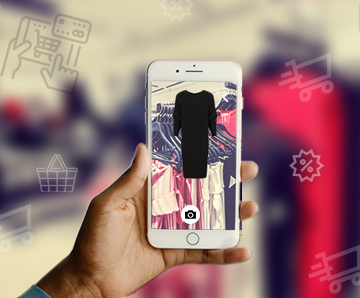
Augmented reality for e-commerce
December,2019
Augmented reality expands our physical world by adding layers of digital information on top of it. Seen through a screen, it offers a realistic view of the physical environment with overlapping computer-generated images, altering the perception of what you see in front of you.
Augmented Reality (AR) has emerged into the retail and e-commerce industry being a great tool for attracting new customers, suggesting that AR may improve online shopping. It also allows e-commerce customers to preview products or enjoy services at their own pace, before choosing to make a purchase. With AR, your customers can preview products and are more likely to pick the right product the first time.
For e-commerce, AR personalizes the online shopping, making it interactive while increasing customer satisfaction and increasing store conversion rates. Technology can enhance the online shopping experience by integrating features unique to physical stores into your smartphone.
Online shopping should be convenient. However, customers face many potential challenges when taking this route. Perhaps their biggest challenge is determining whether a product is right for their life. After all, the images on a screen can be deceptive. When there is not enough information available, consumers will not have the confidence to make a purchase. E-commerce merchants are using AR to solve this problem. Customers can reposition the 3D image on the screen to choose an ideal location for their new room. They may even find that the room they like doesn't go well with the rest of their furniture. In other words, augmented reality can help them make informed decisions.
This innovative technology will have a big impact on the future of e-commerce as it offers creative solutions to many of the big problems that e-commerce businesses face. But, with an augmented reality app, shoppers can experience the product as if they were in a real store. They can even see what it will look like to them. Ikea was an early adopter of this technology, harnessing the power of AR to allow customers to “taste” furniture and see what it will look like in their space. These experiences allow customers to be more determined when purchasing a product, which can lead to increased sales.
One of the biggest disadvantages of the e-commerce industry is the inherent difficulty of trying to virtually represent a product. AR can help bridge the gap between shopping in a physical location and shopping online by making it easier to represent merchandise and giving consumers a better idea of ??what they are buying.
In the era of social distancing, AR is a powerful tool for marketers. This allows consumers to interact with products almost as they would in physical stores, and greater engagement translates into increased sales. There is no doubt that augmented reality will occupy an important place in e-commerce in the future. By improving the user experience, you will keep your customers interested and they will come back for a personalized shopping experience. It can also help increase conversions and sales. While the implementation isn't easy, it's worth doing if you want your e-commerce business to remain competitive in the future.



